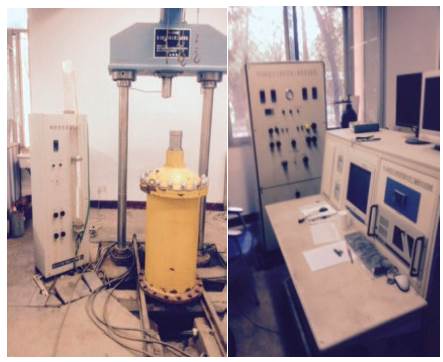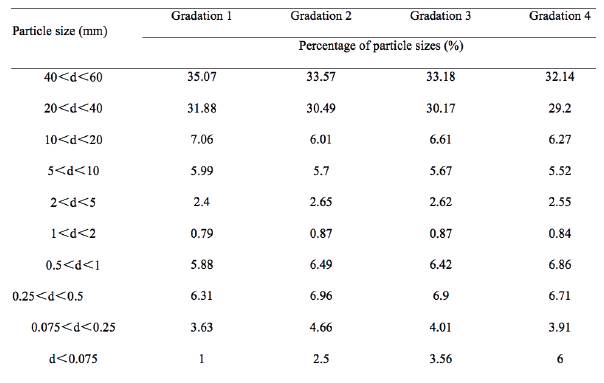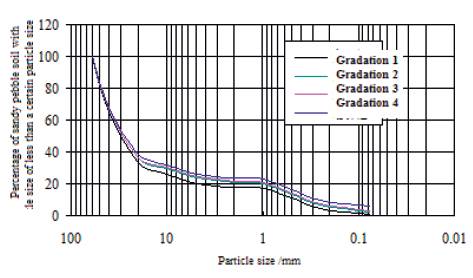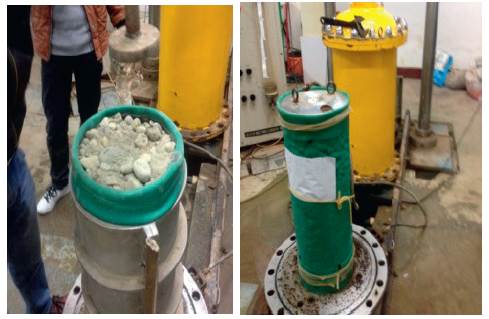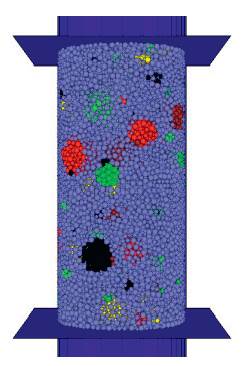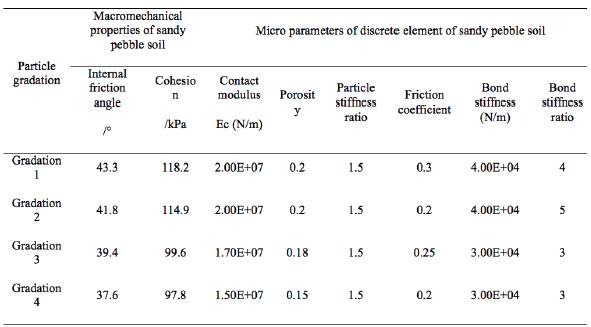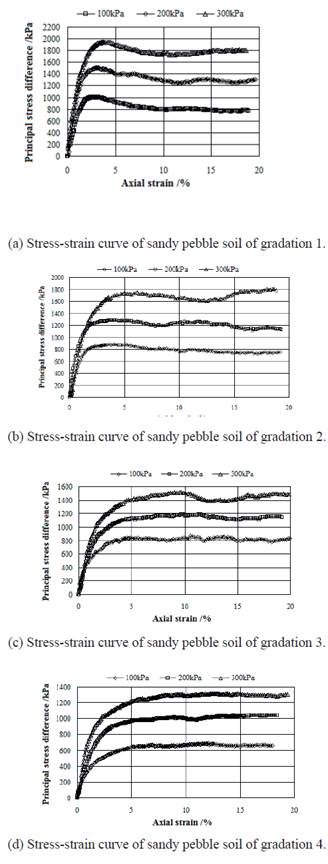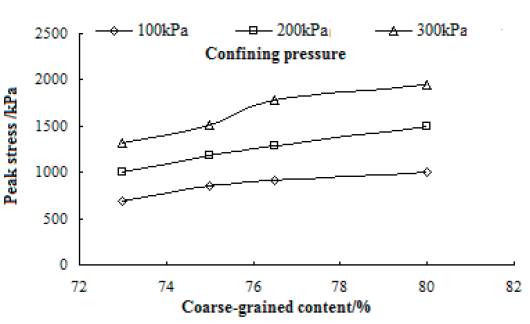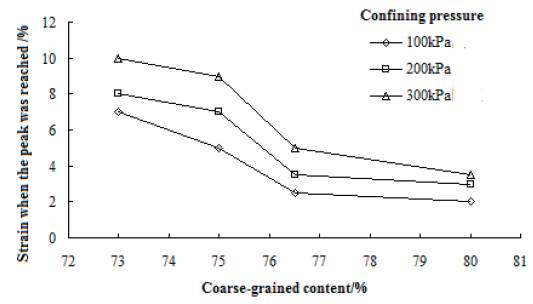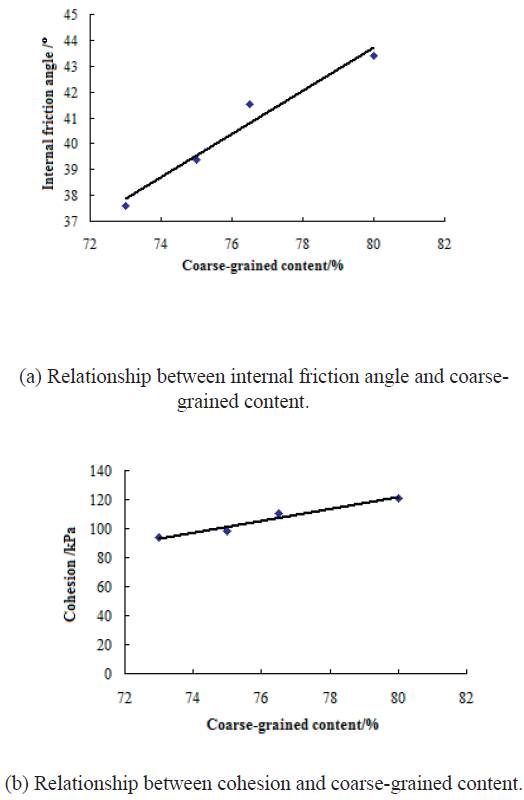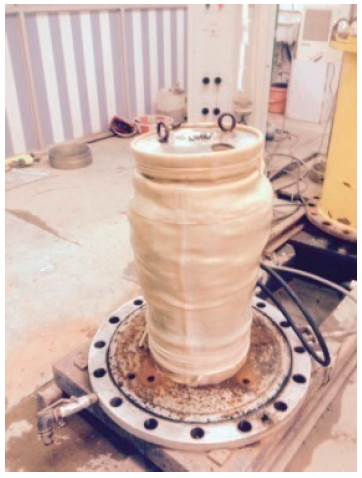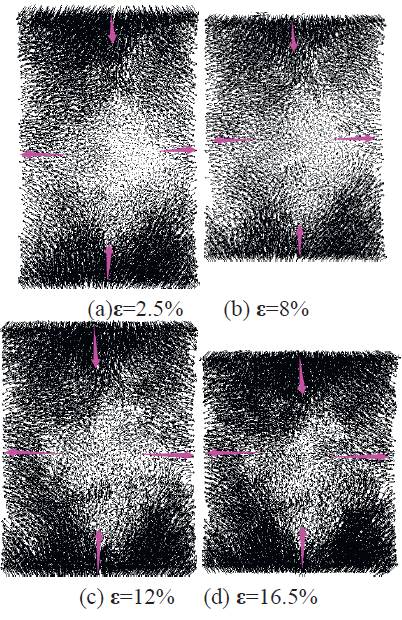INTRODUCTION
Sandy pebble soil is widely distributed in various regions of the world, and its mechanical properties are further complicated by the randomness of geometrical distribution of pebble and discreteness of particle. The sandy pebble stratum widely distributed in Chengdu City, Sichuan Province, China has a great impact on the construction safety of tunnel and underground engineering(Wei et al., 2008; Omara Shahestan and Omara Shastani, 2017), so the study on strength characteristics and stability of sandy pebble soil has been paid increasing attention (Si et al., 1990; Hejazi et al., 2017). Guo Qingguo (1998) proposed 5 mm as the dividing line of fine and coarse particles, and that takes 30% and 70% of coarse-grained contents as the two research points. At the same time, many scholars believed that the physical and mechanical properties of sandy pebble soil of different coarse-grained content such as cohesion, internal friction angle and permeability had a great impact (Wei et al., 2008; Yasin et al., 2017). Most of them conducted studies on macromechanical properties of sandy pebble soil using the triaxial test and direct shear test but lacking micromechanical parameters of the composite structure of sand and pebble particles.
Discrete element method is a numerical simulation method for solving discontinuous media problems, and has received attention from many scholars and was developed since being proposed in the 1970s by Cundall (1997). Geng Li(2011) simulated the triaxial test process using PFC3D, and analyzed the effect of particle micro parameters on the strength of coarse-grained soil, however, it researched on only a gradation of soil, so the conclusions were not representative. Xu Xiaofeng (2013) et al established the calculation model of discrete element simulation of four kinds of gravelly soils of different coarse-grained content, and analyzed the effect mechanism of coarse-grained content on the macro-micromechanical properties of gravelly soil, however, the micro parameters obtained were only suitable for a confining pressure, so it was not accurate enough. Qi Yang (2015) et al simulated the uniaxial loading test of coarse-grained soil in various main stress directions under triaxial state by means of PFC3D, and analyzed the stress-strain characteristics of coarse-grained soil in complex stress state from the macro and micro points of view, believing that the complex stress state was the inducing factor for coarse-grained soil to produce various anisotropies; in addition, many scholars at home and abroad solved the problems of sandy pebble soil encountered in the engineering by using the discrete element theory (Qi et al., 2015; Ahmad et al., 2017).
In this paper, relying on the sandy pebble stratum in Chengdu City, Sichuan Province, China, the influencing law of coarse-grained content on the macromechanical properties of sandy pebble soil was studied using the large-scale triaxial test of coarse-grained soil, on this basis, a particle discrete element numerical triaxial test platform was established, and the micromechanical parameters of sandy pebble soil of different coarsegrained content was studied using the discrete particle element numerical triaxial test (Yasin et al., 2017). The research results provided essential reference and guidance for the fine design, construction, and maintenance of sandy pebble stratum project.
RESEARCH METHOD
TRIAXIAL TEST OF COARSE-GRAINED SOIL
TEST SCHEME
In this test, a stress type large-scale triaxial test apparatus was adopted, and its specifications included a diameter of 300 mm, a height of 600 mm, a maximum axial stress of 21 MPa, a maximum vertical load of 1500 kN, maximum confining pressure of 3.0 MPa, and maximum axial stroke of 300 mm. The shear strength indexes c and φ of coarse-grained soil with the particle size of not less than 60 mm can be measured, as shown in Figure 1.
SPECIMENS
In this test, the sandy pebble soil in Chengdu City, Sichuan Province, China was taken as the research object, for the oversized particles, the weighted average substitution was conducted using the sandy pebble soils with the maximum allowed particle size of 60 mm to 5 mm according to the content, namely equivalent substitution method (Yasin, 2017; Kudus et al., 2017). To obtain the shear strength index of sandy pebble soil of different coarse-grained content, a total of four groups of specimens with P5 (mass percentage of particles with particle size of greater than 5 mm) of 73%, 75%, 76.5% and 80% were adopted in this test, with density of 2.05 g/cm3, moisture content of 1.6%.Each group of specimens was exerted with confining pressures of 100 kPa, 200 kPa, and 300 kPa. The particle gradation of sandy pebble soil used in the test is shown in Table 1 and Figure 2.
The triaxial specimens were divided into three layers for preparation, which allows realizing the uniform mixing of particles. The shearing with an axial strain rate of 1.5 mm/min was carried out using the test method of isotropic consolidation undrained shear until the failure of the specimen occurred (1999), and the specimens are shown in Figure 3.
PARTICLE DISCRETE ELEMENT NUMERICAL TRIAXIAL TEST
ESTABLISHMENT OF NUMERICAL TRIAXIAL TEST PLATFORM
The test silo used in the numerical triaxial test of coarse-grained soil adopted a cylinder with diameter of 300 mm and height of 600 mm, its upper and lower planes were the loading plates with stiffness of greater than particle stiffness, the wall of the test silo adopted the flexible constraint, and its normal stiffness was smaller than normal stiffness of particles (Wun et al., 2017). In the effective area of the test silo, the sphere unit was adopted to replace the soil particle according to the particle gradation of sandy pebble soil tested in the test, the minimum unit diameter in the numerical triaxial test was dmin=1 mm, and the particles of large particle size were composed of small units and classified as a particle group (i.e., Clump unit) (Ridzuan et al., 2017). The contact bond model among particles was adopted, and the servo loading was adopted in the test to keep constant confining pressure. The model of the numerical triaxial test is shown in Figure 4.
METHOD FOR DETERMINING THE MICRO PARAMETERS OF DISCRETE ELEMENT
(1) Determination of particle contact stiffness Ec and ratio kn/ks of normal stiffness to shear stiffness. For the contact bond model, the macro elastic modulus E was mainly determined by the ratio of particle contact stiffness to stiffness. When the particle stiffness ratio was constant, the micro parameter Ec and macro elastic modulus presented linear correlation (Rahman et al., 2017). In the numerical triaxial test, the particle contact stiffness Ec needed to be continuously adjusted until the elastic modulus of numerical model was consistent with the indoor large-scale triaxial test, and the Ec at this time was the micro parameter determined. The stiffness ratio kn/ ks was mainly determined by the Poisson's ratio, the greater the stiffness ratio was, the greater the Poisson's ratio was;
(2) Determination of particle micro parameter friction. The friction coefficient had a great effect on the peak intensity of the model, and little impact on the elastic modulus of the material, by adjusting the friction coefficient until it was similar to the peak intensity of the indoor large-scale triaxial test, the friction coefficient can be determined;
(3) Determination of particle bond strengths σ and τ. The particle bond strength was mainly related to the peak intensity of the model, when the ratio σ mean/σ dev of bond strength average to unbalanced load value was constant, the peak intensity of the model was proportional to the bond strength average.
ANALYSIS OF RESEARCH RESULTS
The stress peak of traditional the triaxial test model of particulate matter under different confining pressure was slightly lower than that of the indoor test, and Potyondy and Hoek et al. (1998) believed that by changing the particle micro parameters to overcome this disadvantage had little effect. In this numerical triaxial test, clump unit was introduced, which efficiently solved this problem. Clump unit was a large particle composed of a plurality ofballs cemented together simulating the particles of irregular shape, which can realize the irregularity of sandy pebble soil, increase the occlusion and embedding among particles, thus appropriately improving the shear strength of the numerical triaxial test.
ANALYSIS OF MACROMECHANICAL PROPERTIES OF SANDY PEBBLE SOIL
STRESS-STRAIN CHARACTERISTICS OF SANDY PEBBLE SOIL OF DIFFERENT COARSE-GRAINED CONTENT
From Figure 5, it can be seen that the stress-strain curve of sandy pebble soil exhibited strain softening with the increase of coarse-grained content, this was because, with the increase of coarse-grained content, particles became overhead, formed large pores, and lacked fine particles to fill, resulting in the decrease of stress with the increase of strain (Zhang et al., 2013; Basarían and Tahir, 2017). From Figs. 6 and 7, it can be seen that when the confining pressure was the same, the stress maximum increased and the strain when the peak was reached decreased gradually with the increase of coarse-grained content.
ANALYSIS OF MACROMECHANICAL PARAMETERS OF SANDY PEBBLE SOIL
From Figure 8, it can be seen that the internal friction angle and cohesion of sandy pebble soil linearly increased with the increase of coarse-grained content, but with different increasing magnitude, by fitting, the relationship between mechanical parameters and coarsegrained content of sandy pebble soil was obtained as follows:
Where: φ-internal friction angle, (°); c- cohesion, (kPa).
P5-mass percentage of particles with particle size of greater than 5 mm
ANALYSIS OF MICROMECHANICAL PROPERTIES OF SANDY PEBBLE SOIL
Based on the results of the indoor large-scale triaxial test of coarse-grained soil, the optimal micro parameters of sandy pebble soil of different coarse-grained content were obtained by using the approximation method of parameters of particle numerical triaxial test.
STRESS-STRAIN CURVE OF NUMERICAL TRIAXIAL TEST OF SANDY
PEBBLE SOIL OF DIFFERENT COARSE-GRAINED CONTENT
As can be seen from Figure 9, the stress-strain curve of the discrete element numerical triaxial test was in substantial agreement with that of the indoor test, and the micro parameters of the discrete element determined by this method can well realize the macromechanical properties of sandy pebble soil.
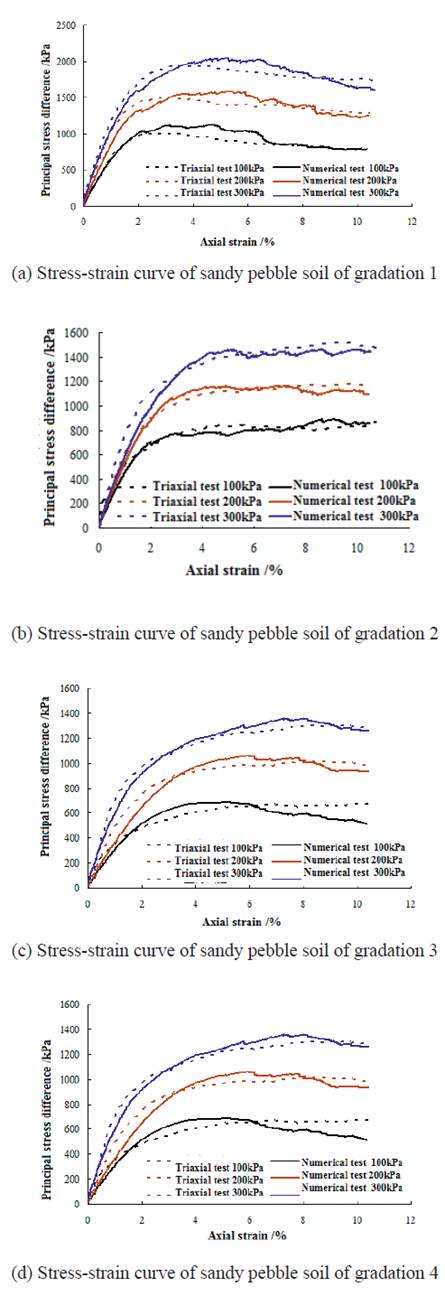
Figure 9 Stress-strain curve of sandy pebble soil of different coarse-grained content in the real and numerical triaxial test.
When the triaxial confining pressure was the same, the stress peak increased, but with different initial modulus, this was primarily because the basic unit of discrete element was the rigid sphere, and the occlusion of particles was weak, and the particles were arranged in single form, even if the contact bond was selected to improve the cohesion of particles (Bilal et al., 2017). However, with the increase of axial load, the bond fracture led to strength characteristics of sandy pebble soil different from the actual strength characteristics of sandy pebble soil, which also needed to be improved and further optimized.
MICROMECHANICAL PARAMETERS OF DISCRETE ELEMENT OF SANDY PEBBLE SOIL
By checking calculation, the micro parameters of discrete element able to reflect the macromechanical properties of sandy pebble soil of different coarse-grained content were obtained, the determination of the micro parameters of the discrete element provided the basic data for the numerical analysis and design of sandy pebble soil. The specific micro parameters of the discrete element are shown in Table 2.
Table 2 showed that the micromechanical parameters of sandy pebble soil were mainly determined by contact modulus, porosity, friction coefficient, bond stiffness and bond stiffness ratio. The more the coarse-grained content was, the larger the contact modulus and friction coefficient were, and the higher the internal friction angle and cohesion of sandy pebble soil were, but the other micro parameters showed little change (Nema et al., 2017). Therefore, the fact that the strength of sandy pebble soil increased with the increase of coarsegrained content was caused by particle stiffness and friction coefficient.
ANALYSIS OF DISPLACEMENT OF SANDY PEBBLE SOIL PARTICLES
The displacement of sandy pebble soil particles in the triaxial compression process was analyzed, to reveal the micromovement of sandy pebble soil particles in the triaxial compression process. Because the coarse-grained content of sandy pebble soils of four different gradations had little difference, so their particle displacement fields showed no difference (Andik and Sarang, 2017). When the sandy pebble soil of gradation one was selected, the displacement was analyzed with particle displacement field of 100 kPa of confining pressure as the representative, and the microdisplacement diagram of particles under different strain is shown in Figure 11. From the beginning of compression shear, due to movement of upper and lower loading plates, the particles in the upper part of the model moved downward, and the particles in the lower part of the model moved upward. As the loading progressed, the particles in the middle of the model moved outward due to pressure, resulting in the dilatancy of specimens in the middle of the model, which was the same as the failure mode (Figure 10) of samples in the indoor test.
CONCLUSION
In this paper, the macromechanical parameters of sandy pebble soil of different coarse-grained content were obtained using the indoor large-scale triaxial test of sandy pebble soil, and the discrete element numerical triaxial model of sandy pebble soil was established. By checking calculation, the micromechanical parameters of sandy pebble soils of four different gradations were obtained, and the effect of coarse-grained content on the mechanical properties of sandy pebble soil was analyzed from the macro and micro points of view, and the following conclusions were obtained:
The stress-strain curve of sandy pebble soil exhibited strain softening with the rise of coarse-grained content; when the confining pressure was the same, the stress peak increased gradually with the increase of coarse-grained content;
The shear strength of sandy pebble soil increased steadily with the increase of coarse-grained content, and the internal friction angle and cohesion of sandy pebble soil linearly increased with the rise of coarse-grained content;
Based on the micromechanical parameters of sandy pebble soil in the triaxial test, the micromechanical parameters of discrete element of sandy pebble soil of four different gradations were obtained using the comparative data method of numerical triaxial test, providing the theoretical support for the fine research on stability of sandy pebble soil;
The increase of the coarse-grained content of sandy pebble soil resulted in increased contact stiffness and friction coefficient of micro parameters of discrete element, thus increasing the strength of sandy pebble soil;
The dilatancy of specimens was caused by the particles in the upper and lower parts of the model moving to the middle and the particles in the middle of the model moving outward, and the numerical triaxial test can better reproduce the triaxial compression process.













